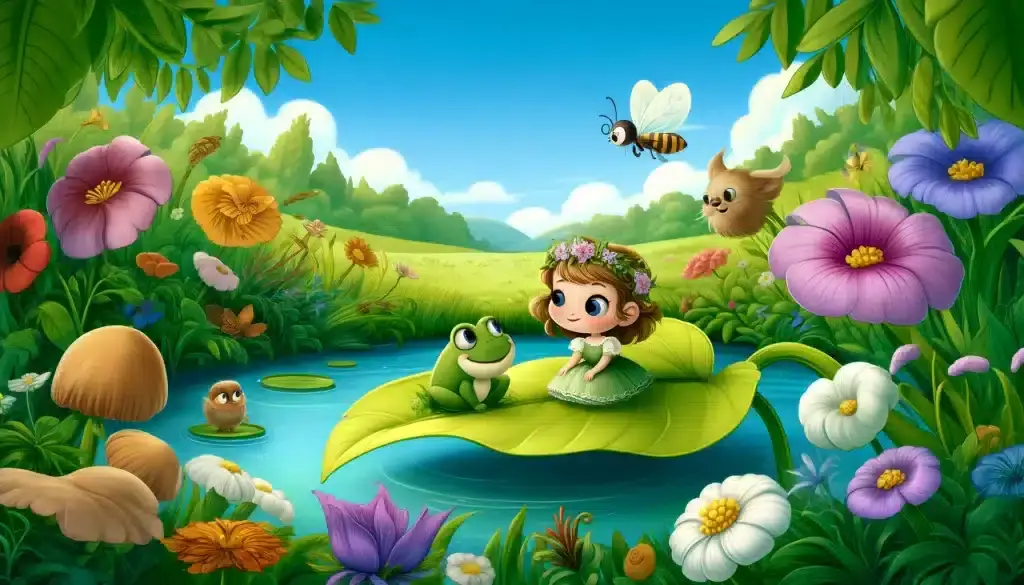Thumbelina Andersen’s Original Fairy Tale. It was penned by the famed Danish author Hans Christian Andersen, endures as a cherished narrative that has captivated hearts for generations. Though initially published in 1835 as part of a collection of stories for children, its enchantment remains undiminished.
The story unfurls the tiny, eponymous heroine’s adventures in a world that’s far too expansive for her minuscule stature. But why does the tale of Thumbelina continue to resonate with audiences, young and old alike?

The beauty of Thumbelina lies in her journey—a narrative that mirrors our own lives. We’re often thrown into situations that seem insurmountable, where we feel as small and powerless as Thumbelina herself. Yet, it’s her courage and resilience in the face of outsized challenges that inspire us.
Amidst her encounters with toads, moles, and beetles, what can Thumbelina’s trials and triumphs teach us about hope and the human spirit?
Through Andersen’s narrative, Thumbelina confronts societal expectations and norms, just as we do in our own lives. It challenges preconceptions of strength and where it truly comes from.
While Thumbelina’s tale springs from a place of fantasy, its themes are grounded in reality, offering a fresh viewpoint on how to navigate a world that doesn’t always see us for who we truly are.
How might her experiences shed light on the ways we engage with our allies and adversaries, and the choices that can lead us to our own version of a happily ever after?
Author’s Background

This section delves into the intriguing life and literary journey of Hans Christian Andersen, the figure behind timeless classics, including the endearing story of “Thumbelina.” It’s a glimpse into the man whose personal narrative is as captivating as the tales he penned.
Hans Christian Andersen’s Life
Born on April 2, 1805, in Odense, Denmark, Hans Christian Andersen’s life was not a fairytale start. The son of a shoemaker and a washerwoman, his early years were marked by poverty.
Despite the humble beginnings, Andersen’s imagination was rich, and it fueled his passion for literature and storytelling. He left home at 14, seeking fortune and recognition in Copenhagen.
His early experiences of hardship and the relentless pursuit of his dreams resonate deeply with the struggles characters face in his stories, such as Thumbelina’s journey through a daunting world.
Literary Career
Andersen’s literary career began in the 1820s, though it was in the 1830s with the release of his “Fairy Tales Told for Children” that his unique talent for storytelling truly shone.
He did not just write stories; he crafted entire worlds that reflected the complex human conditions through simple, magical tales. His portfolio grew to include novels, travelogues, and plays, but he is best known today for his fairy tales.
Andersen’s work opened a portal to worlds where the smallest individuals, like Thumbelina, could have the grandest adventures, teaching readers that courage and resilience are size-independent. He brought a sense of wonder and possibility to children and adults alike, leaving a literary legacy that continues to inspire and entertain.
Publication and Historical Context

Thumbelina’s journey from a handwritten manuscript to a beloved classic reflects not just the creative process of Hans Christian Andersen but also the cultural fabric of the 19th century. This section unveils the story’s original publication details and its cultural significance.
Original Publication
Thumbelina, a tale woven with the magic of miniature wonders, saw its first light of day in 1835 as part of a booklet series titled “Eventyr, fortalte for Børn” (Fairy Tales, Told for Children). Andersen introduced this tale alongside “The Naughty Boy” and “The Traveling Companion,” marking the second installment of his enduring contributions to children’s literature.
The story was published by Danish publisher C. A. Reitzel in Copenhagen, Denmark. Learn more about the fairy tale’s journey through Thumbelina’s Wikipedia page.
Cultural Significance
Why does Thumbelina remain significant in a world vastly different from 19th-century Denmark? The charm of Thumbelina’s narrative lies not just in its appeal to children, but also in its reflections on society and the intricate relationship between humans and nature.
Thumbelina, the thumb-sized heroine, represents courage and the unexpected strength that may reside in the seemingly smallest members of society. Her story has been translated into countless languages and adapted into various media, confirming its universal appeal.
Dive deeper into Andersen’s narrative choices on Thumbelina, analysis by Hans Christian Andersen.
Plot Summary

In Hans Christian Andersen’s tale, a miniature girl goes through a saga of trials and wonder, looking for a place where she belongs. Thumbelina’s size lays the groundwork for unique challenges and friendships, ultimately leading her to a destiny far beyond her beginnings.
Beginning of Thumbelina’s Journey
A woman’s deep desire for a child is fulfilled by a fairy who provides her with a barleycorn that grows into a flower, from which Thumbelina emerges. Standing no taller than a thumb, she finds herself in a world that is both wondrous and foreboding.
Thumbelina’s Adventures
Thumbelina faces several distressing suitors: a toad who abducts her to marry her son; a beetle that discards her when his friends deem her too different; and a mole who desires her as his companion, unaware of her yearning for the sunlight he shuns.
Each encounter teaches her more about valuing herself and the search for true happiness.
The Ending and Moral
The tale culminates with Thumbelina rescuing a swallow and being granted wings by the queen of the fairies, finally marrying a fairy prince. The moral, woven discreetly through her journey, promotes the virtues of kindness, bravery, and being true to oneself.
Characters Analysis

In Hans Christian Andersen’s beloved tale, “Thumbelina,” characters leap from the page as vivid and distinct individuals, each with their unique role in the narrative. They embody the central themes of kindness, courage, and the search for belonging.
Thumbelina
Thumbelina is a thumb-sized girl born from a flower who symbolizes the virtues of compassion and resilience. Despite her diminutive size, she exhibits a tremendous spirit, facing obstacles and adversaries with grace and bravery. Her journey is one of transformation and self-discovery as she navigates through a world that is vast and challenging.
Thumbelina’s Antagonists
The antagonists in the story, including the toad, the cockchafer, and the mole, each challenge Thumbelina in their own way. The toad kidnaps her with intentions of marrying her to her son, while the cockchafer ridicules her for her small size and the mole dismisses the importance of sunlight and the outdoors, which are essential to Thumbelina.
These characters not only create conflict but also serve to highlight Thumbelina’s strength of character.
Supporting Characters
The supporting characters aid Thumbelina throughout her trials. The swallow, whom Thumbelina nurses back to health, becomes a friend and eventually guides her to the land of the flowers, where she meets the flower-fairy prince.
Other characters, like the friendly mouse, offer Thumbelina shelter and advice, even if their ideas of happiness differ from hers. These characters facilitate Thumbelina’s growth and her quest for a place where she truly belongs.
Themes and Symbolism

In Hans Christian Andersen’s “Thumbelina,” profound themes intertwine with rich symbolism, reflecting on individual worth and nature’s cycles through the lens of a miniature protagonist. Here, size becomes a metaphor for identity, seasons signify life’s chapters, and the contrasting desires for freedom and confinement emerge as pivotal struggles.
Size and Identity
Thumbelina’s diminutive stature symbolizes the challenges she faces in finding her place in a world that often overlooks the small and the seemingly insignificant. Despite her size, she embodies strength and determination.
It’s her tiny frame that both defines her and defies the expectations of her larger-than-life adventures.
Nature and Seasons
The seasonal shifts in “Thumbelina” paint a vibrant backdrop that mirrors the character’s own transformation. Spring represents new beginnings, just as Thumbelina blooms into existence; summer is the fullness of life where she meets friends and foes; autumn reflects challenges and decay as she loses hope; and winter brings the hardship before the renewal of her story in a cycle that parallels the resilience found in nature.
Freedom and Captivity
Throughout the tale, Thumbelina encounters a series of confinements, each reflecting fears and desires of losing and regaining freedom. She is coveted for her unique beauty but is not seen beyond her appearance, leading to a series of imprisonments—from the toad’s watery lair to the mole’s dark tunnel.
Thumbelina’s quest for autonomy and self-direction is a poignant symbol for the universal longing to forge one’s path and escape the constraints placed by society.
Adaptations and Influence

Thumbelina’s tale has resonated through generations, not just as a story for children, but as a canvas for creative minds. From cinematic renditions to artistic interpretations, her minute size and grand adventures remind us that courage knows no bounds.
Film and Television
Thumbelina has been a muse for storytellers in the film and television industry, inspiring numerous adaptations.
In 1994, Don Bluth’s animated feature film, Thumbelina, presented a musical reimagining of the character’s journeys, which brought the tiny heroine’s tale to screens worldwide.
The charm of Thumbelina’s story lends itself to adaptations across varied cultures, including Japanese animated series that introduced her to a new audience during the 1970s.
Literature and Art
The literature and art world embraced Thumbelina, with books and artworks exploring the fairy tale’s themes.
Illustrators have often delved into the pictorial potential of the story. They use Thumbelina’s delicate frame juxtaposed against a world of giant flora to create compelling visuals.
Alan Aldridge’s illustrations echo the tale’s otherworldliness while giving readers a fresh visual companion to Andersen’s words.
Similarly, contemporary picture books continue to explore and reinterpret the tale, ensuring Thumbelina remains an icon of children’s literature.
Popular Culture
In popular culture, Thumbelina’s influence extends beyond the confines of direct adaptations.
References to her appear in unexpected places, from TV commercials that play on her diminutive size to conveying messages of strength, to modern literature that sometimes features protagonists facing ‘Thumbelina-esque’ challenges.
The notion of a tiny individual making their way through a daunting world has been a recurrent motif, sparking conversations about bravery and resilience across forums and mediums.
Critical Reception

When Hans Christian Andersen’s fairy tale ‘Thumbelina’ was first published in 1835, it marked a significant entry in the world of literature. But what exactly captivated readers about this little girl no bigger than a thumb?
Readers throughout generations have been charmed by Thumbelina’s tenacity and kindness, qualities that shine in the face of her numerous challenges.
Literature enthusiasts often highlight how Andersen’s work deftly deals with themes of identity and belonging.
Isn’t it fascinating to consider why such a small character has made such a huge impact?
Critics and scholars alike analyze Thumbelina not just as a narrative but as a reflection of human virtues and resilience.
Have you ever marveled at her ability to maintain hope in almost impossible circumstances? This aspect of Thumbelina’s character has inspired thoughtful discussions on the human spirit’s strength, irrespective of one’s size or power.
The tale also received appreciation for its imaginative elements and the sweetness of its happy ending, where Thumbelina finds love and kinship.
Truly, Andersen’s ability to culminate hardship with joy is worth noting. How does this hopeful conclusion resonate with our own desires for a happy resolution in life’s trials?
Moreover, educators and parents acknowledge the educational core of Thumbelina’s story, which demonstrates the importance of empathy and courage.
These timeless values continue to earn ‘Thumbelina’ a cherished spot on children’s bookshelves around the world.
Legacy and Relevance

Hans Christian Andersen’s “Thumbelina” has transcended the years, evolving into more than just a tale for children’s bedtime.
For starters, the narrative of a thumb-sized girl encountering a vast world has become a metaphor for the universal experience of facing life’s enormous challenges.
It’s not just a story; it’s a reflection on vulnerability and strength.
When you hear about Thumbelina’s obstacles, don’t they resonate with the times you’ve faced seemingly insurmountable odds?
The tale’s enduring appeal rests on its ability to mirror our own journey of resilience and self-discovery.
Through its legacy, “Thumbelina” has become a cultural touchstone.
Have you noticed renditions of the story in movies, books, or even music? These adaptations explore themes of courage and compassion, demonstrating Thumbelina’s impact on the arts.
What’s remarkable is its relevance today. Andersen’s story continues to offer fresh insights into societal norms — what does it mean to be small in a big world?
“Thumbelina” challenges the traditional idea of a hero, presenting an unlikely protagonist who navigates her environment with optimism and heart.
This tale, once nested within the pages of a Danish book, has bloomed like Thumbelina herself, into something universally accessible and continually inspiring.
Its relevance lies in its simplicity — the hope that even the smallest among us can find their own place in the sun.
Steve is the creative force behind Unique Tales, a blog dedicated to sharing captivating stories that explore the human experience in all its complexity. With a passion for writing and a talent for crafting engaging narratives, Steve's blog is a treasure trove of imaginative tales that transport readers to other worlds and challenge them to see things from new perspectives. From epic adventures to intimate character studies, Steve's stories are always thought-provoking and emotionally resonant. With a growing following of readers who appreciate his unique voice and creative vision, Steve is quickly becoming a rising star in the world of online storytelling.






